Advertisements
Advertisements
Question
How does the angle of deviation produced by a prism change with increase in the angle of incidence. Draw a curve showing the variation in the angle of deviation with the angle of incidence at a prism surface.
Solution 1
As the angle of incidence increases, the angle of deviation decreases first and reaches to a minimum value (δm) for a certain angle of incidence. By further increasing the angle of incidence, the angle of deviation is found to increase.
Variation of angle of deviation (δ) with angle of incidence(i):
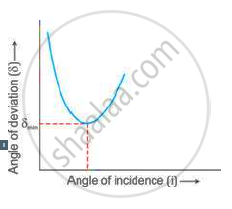
Solution 2
The deviation angle first increases with increasing incidence angle and then decreases. From figure,
δ = δ1 + δ2 ....(i)
and i = δ1 +γ1 ; e = δ2 +γ2
⇒ i = γ1 = δ1 ....(ii)
⇒ e - γ1 = δ2 ....(iii)
from ΔON1 N2
γ1 +γ2 + ∠N1 ON2=180° ....(iv)
from cyclic quadrilateral
∠A + ∠N1ON2 = 180° ....(v)
from (iv) and (v)
γ1 +γ2 = A
δ = i - γ1 + e - γ2
=( i - e) - (γ1 + γ2) ...(vi)
at δm ;
i = e ; γ1 = γ2= γ
δm =2i - A ...(vii)
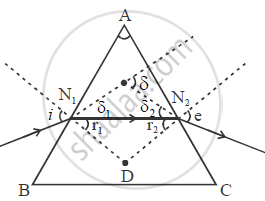
The variation in the angle of deviation with the angle of incidence at a prism surface
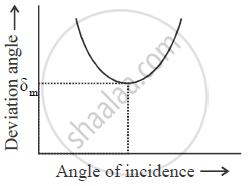
Graph between i and δm
APPEARS IN
RELATED QUESTIONS
A student traces the path of a ray of light passing through a rectangular glass slab and marks the angle of incidence i, angle of refraction r and angle of emergence e, as shown.
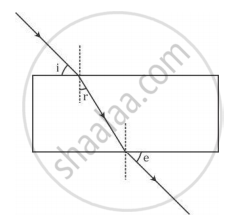
The correctly marked angle(s) is/are
(A) ∠ i only
(B) ∠ e only
(C) ∠ r only
(D) ∠ i and ∠ e
A ray of light passes from glass into air. The angle of refraction will be:
(a) equal to the angle of incidence
(b) greater than the angle of incidence
(c) smaller than the angle of incidence
(d) 45°
Select from the following the best experimental set-up for tracing the path of a ray of light through a glass slab: (A) I
(A) I
(B) II
(C) III
(D) IV
Draw an í- `delta` graph for a mono chromatic raY through a glass prism of a plane and mark
(i) `delta` m, the angle of mínimum devíation
(íí) Any two values of i for which value of `delta` ís same.
Make the correct for each of the following :
With reference to the fig, the refractive index of the glass block is
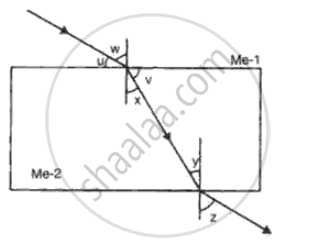
A ray of light passes from water to air. How does the speed of light change?
Explain briefly what causes the twinkling of stars at night.
Draw ray of light bending towards the normal while passing from air to glass. Label your diagrams.
In the diagram alongside a ray of light, PQ is incident normally on one face AB of an equilateral glass prism. What is the angle of incidence at the faces AB and AC?
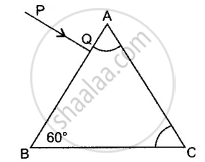
What is lateral displacement?
